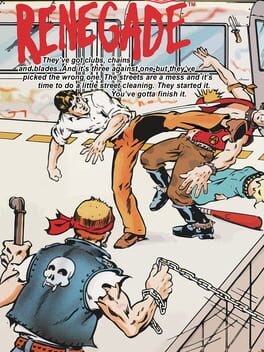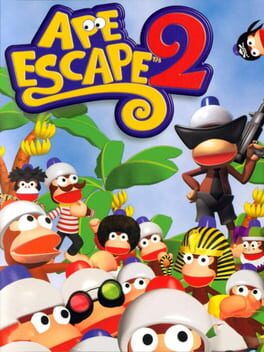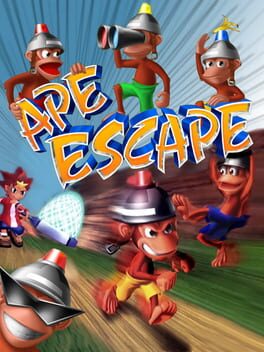VolcanicDynamo
Bio
Nothing here!
Badges

On Schedule
Journaled games once a day for a week straight

Noticed
Gained 3+ followers

GOTY '23
Participated in the 2023 Game of the Year Event

Gamer
Played 250+ games

N00b
Played 100+ games
Favorite Games
444
Total Games Played
023
Played in 2024
509
Games Backloggd
Recently Played See More
Recently Reviewed See More
This is the localized version of Nekketsu Kōha Kunio-kun. It is mechanically identical to the Japanese version (which is covered in my review of that game), but the original setting with high school delinquents (inspired by director and designer Yoshihisa Kishimoto's childhood of getting into fights) are replaced by an American setting with street gangs and mob bosses. The story, originally about saving a fellow student from a yakuza boss, has also been replaced with saving the lead's girlfriend, but while the Famicom game keeps the story in the game, the NES game lacks the intro and ending. This makes Renegade marginally worse than Nekketsu Kōha Kunio-kun in my eyes, but if you only have access to one of the two, this is a fine version to play.
Originally released as "Nekketsu Kōha Kunio-kun," this title was massively influential on the beat 'em up genre. It introduced staples such as belt scrolling, a bigger focus on combos, and urban environments. The reason I'm playing it, however, is because it is the first in the long line of Kunio-kun games, the birthplace of a favorite game of mine, River City Ransom.
...well, sort of. This is the home version, freshly translated for the Double Dragon & Kunio-kun: Retro Brawler Bundle. This port makes some changes from the original, namely having less enemies on screen at a time and dividing levels into multiple segments. However, the aspects that made the original famous are still here.
Nekketsu Renegade Kunio-kun uses a two button attack system based on Kunio's current direction. B always makes you attack to the left while A always makes you attack to the right. Depending on where Kunio is facing, this means either a quick forward punch you can mash or a slower, longer ranged backwards kick. This also affects some of the other moves you can pull off. You can grab a stunned enemy, hitting them for more damage with the forward attack and throwing then with the back attack. You can pummel grounded enemies by pressing down and using the forward attack. You can dash forward and knock enemies down with a running punch. It takes time to get used to remembering the directional aspect of these moves. I initially struggled with crowds and bosses, relying heavily on save states in between levels and before bosses to survive. But with some time and practice, you can master spacing and crowd control, and I can more reliably get through the rest of the game without help.
There is one move I neglected to mention: the jumping kick, pulled off by pressing both buttons at the same time. This move is kinda busted. It stuns enemies in one hit, letting you go in for a grab. It knocks enemies down in two, letting you focus on another enemy or pummel the now grounded foe. It is the only attack to deal with motorcycle enemies in stages 2 and 4, and it is the best attack for dealing with bosses assuming your timing and spacing is good. Sure, enemies can duck sometimes, but most times, you can just...do it again to hit an enemy. Master this move, and the game can become a lot easier.
To further even the playing field, there are hidden power ups you can find by performing specific techniques. Bust open a wall at the right time to get health. Defeat the third enemy of each room with a pummel when the timer is even to get an extra life. Jump kick an enemy at the right time to get a power boost that lets you send your enemies flying in a single punch. A good reason to check the manual of any retro game you play - you get to learn stuff that isn't necessarily communicated by the game itself.
You'll need a bit of broken stuff, however, since these bosses are devious. Jump kicks are enough for the first two, but they're much tougher without it. The third boss can easily grab and drain tons of health quickly, requiring good spacing on your attacks. That final boss is the smartest brawler boss, bringing a gun to a fist fight that can instantly kill you, though good timing with jump kicks can leave him unable to use his weapon. It is these tougher fights and need for timing, alongside the maze in the final level, that help to maintain the difficulty even with the jump kick at your disposal. This challenge goes even higher in the second and third difficulty levels, which add more weapon wielding enemies and make the final level maze even tougher. I tried with level 2, but having to fight multiples of the third stage boss in just two minutes was extremely frustrating and I had to tap out.
If you're not interested in the history of the beat 'em up, you can skip Nekketsu Renegade Kunio-kun. This is a super short game with awkward controls and wild endgame difficulty spikes. But the nuances in mechanics that shined in the 80s still have merit today.
...well, sort of. This is the home version, freshly translated for the Double Dragon & Kunio-kun: Retro Brawler Bundle. This port makes some changes from the original, namely having less enemies on screen at a time and dividing levels into multiple segments. However, the aspects that made the original famous are still here.
Nekketsu Renegade Kunio-kun uses a two button attack system based on Kunio's current direction. B always makes you attack to the left while A always makes you attack to the right. Depending on where Kunio is facing, this means either a quick forward punch you can mash or a slower, longer ranged backwards kick. This also affects some of the other moves you can pull off. You can grab a stunned enemy, hitting them for more damage with the forward attack and throwing then with the back attack. You can pummel grounded enemies by pressing down and using the forward attack. You can dash forward and knock enemies down with a running punch. It takes time to get used to remembering the directional aspect of these moves. I initially struggled with crowds and bosses, relying heavily on save states in between levels and before bosses to survive. But with some time and practice, you can master spacing and crowd control, and I can more reliably get through the rest of the game without help.
There is one move I neglected to mention: the jumping kick, pulled off by pressing both buttons at the same time. This move is kinda busted. It stuns enemies in one hit, letting you go in for a grab. It knocks enemies down in two, letting you focus on another enemy or pummel the now grounded foe. It is the only attack to deal with motorcycle enemies in stages 2 and 4, and it is the best attack for dealing with bosses assuming your timing and spacing is good. Sure, enemies can duck sometimes, but most times, you can just...do it again to hit an enemy. Master this move, and the game can become a lot easier.
To further even the playing field, there are hidden power ups you can find by performing specific techniques. Bust open a wall at the right time to get health. Defeat the third enemy of each room with a pummel when the timer is even to get an extra life. Jump kick an enemy at the right time to get a power boost that lets you send your enemies flying in a single punch. A good reason to check the manual of any retro game you play - you get to learn stuff that isn't necessarily communicated by the game itself.
You'll need a bit of broken stuff, however, since these bosses are devious. Jump kicks are enough for the first two, but they're much tougher without it. The third boss can easily grab and drain tons of health quickly, requiring good spacing on your attacks. That final boss is the smartest brawler boss, bringing a gun to a fist fight that can instantly kill you, though good timing with jump kicks can leave him unable to use his weapon. It is these tougher fights and need for timing, alongside the maze in the final level, that help to maintain the difficulty even with the jump kick at your disposal. This challenge goes even higher in the second and third difficulty levels, which add more weapon wielding enemies and make the final level maze even tougher. I tried with level 2, but having to fight multiples of the third stage boss in just two minutes was extremely frustrating and I had to tap out.
If you're not interested in the history of the beat 'em up, you can skip Nekketsu Renegade Kunio-kun. This is a super short game with awkward controls and wild endgame difficulty spikes. But the nuances in mechanics that shined in the 80s still have merit today.
Today's DualSense controller owes much to the original DualShock. While Nintendo and Sega placed single analog sticks onto their controllers, Sony's offering (itself an evolution of their Analog Joystick and Dual Analog controllers) offered two sticks and built-in vibration features. These now-standard features would be widely supported across many PlayStation games, but most games would not require the controller. But Sony's Japan Studio set out to make a title taking advantage of the dual analog sticks for innovative gameplay, cresting the first game to require the DualShock controller: Ape Escape.
Ape Escape places you in the role of Spike, a boy caught up in an Ape uprising. Specter, a monkey from the amusement park, has gotten his hands on a Peak Point Helmet, an invention that boosts his brain power - and his desire to conquer the world. He and his fellow apes have commandeered the professor's time machine to try and rewrite history, and it's up to Spike to travel through numerous eras and catch those mischievous monkeys.
Modern 3D platformers typically use the left analog stick for movement and the right analog stick to control the camera. Ape Escape takes a different approach. Camera adjustments are done via the directional pad and a camera re-center button. Instead, right stick is used to control the various gadgets you use on your quest, and you select these tools by assigning them to the face buttons. Need to catch a monkey with your Time Net? Tilt the stick in the direction of the monkey. Swinging your stun club? Tilt the stick, or spin it around for a spinning attack. Charging up your Sky Flyer or Super Hoop? Spin that stick. Have an RC Car to drive around? Move yourself with one stick and the RC Car with the other. This dual analog control extends to other aspects as well, from the occasional vehicle segment to the three unlockable mini games.
Even as someone who played the Ape Escape games as a kid, these controls took time to get used to again. Jumping initially felt very awkward (a combo of getting used to pressing a shoulder button and it being a little slow), and I wasn't getting the best view of my surroundings. Each gadget also required a bit of learning to get used to, something the game facilitates with its mandatory training rooms. In truth, I never got used to those vehicle sections, even as I improved. But as I played more, the rest clicked. While I wouldn't always get the perfect camera angle (mostly down to early 3D cameras more than the camera input), camera control on the move was as simple as pressing the re-center button to get my bearings and using the first person look if I wanted a specific angle. Jumping became easier to pull off, especially with the Sky Flyer gadget. And speaking of those gadgets - you get a fun selection to play with! Some are focused on catching monkeys or attacking enemies while others are focused on movement or puzzle solving. You have a solid balance of new abilities being introduced every few levels, and levels would have a good mix of level specific hazards and gadget specific sections (new and old).
Your main goal is to capture a specific number of apes each level. These simian sensations are a combination of enemy and collectible, fighting your attempts to capture them with various means. Banana peels, rapid swings, laser guns, missile packs, UFOs, all sorts of stuff. Sure, you can run upto an early monkey and catch them with a swing of the Stun Club followed by your Time Net, but you can often get better results by sneaking up on a monkey or using a specific gadget to stun or reach them. While Ape Escape does feature more traditional enemies to fight, the 204 apes you can capture are the highlight, making for a fun spin on the collectathon platformer that was so common in the era. And if collecting monkeys ain't enough for you, there are also 60 Specter Coins hidden throughout the game (collect at least 40 of them to unlock all three mini games).
When you capture the required amount of apes, it's onto the next level, and you'll steadily progress through the game's 19 main areas and two bonus races against your hypnotized best friend. That's all it takes to roll the credits, but if you want to take down Specter once and for all, you'll need to catch every single monkey in the game. While you can clear some levels as soon as they are available, others require the use of gadgets from later levels, including a gadget that unlocks in the postgame. Luckily, going back through levels with a fully decked out Spike ended up being pretty fun. You have all sorts of new tools at your disposal to nab even simple apes, and the postgame gadget excels at combat (dealing double damage and having more range than the stun club), exploration (opening new areas or shortcuts in existing areas), and monkey catching (the extra range makes stunning them a lot easier). And if you really want to go above and beyond, there are optional time trials to get that 100% rating on your file.
Ape Escape definitely feels of its era, in both good and bad ways. We have some really charming 3D art, but we also have a pretty short draw distance. We have a delightful DnB/electronic soundtrack by Soichi Terada, but we also have some not so great voice acting in the U.S. dub. The control scheme is creative and innovative, but it isn't the modern standard and it definitely takes getting used to. But this is an adventure worth getting used to and one I recommend to any 3D platfomer fan who doesn't mind a little PS1 novelty and jank.
Ape Escape places you in the role of Spike, a boy caught up in an Ape uprising. Specter, a monkey from the amusement park, has gotten his hands on a Peak Point Helmet, an invention that boosts his brain power - and his desire to conquer the world. He and his fellow apes have commandeered the professor's time machine to try and rewrite history, and it's up to Spike to travel through numerous eras and catch those mischievous monkeys.
Modern 3D platformers typically use the left analog stick for movement and the right analog stick to control the camera. Ape Escape takes a different approach. Camera adjustments are done via the directional pad and a camera re-center button. Instead, right stick is used to control the various gadgets you use on your quest, and you select these tools by assigning them to the face buttons. Need to catch a monkey with your Time Net? Tilt the stick in the direction of the monkey. Swinging your stun club? Tilt the stick, or spin it around for a spinning attack. Charging up your Sky Flyer or Super Hoop? Spin that stick. Have an RC Car to drive around? Move yourself with one stick and the RC Car with the other. This dual analog control extends to other aspects as well, from the occasional vehicle segment to the three unlockable mini games.
Even as someone who played the Ape Escape games as a kid, these controls took time to get used to again. Jumping initially felt very awkward (a combo of getting used to pressing a shoulder button and it being a little slow), and I wasn't getting the best view of my surroundings. Each gadget also required a bit of learning to get used to, something the game facilitates with its mandatory training rooms. In truth, I never got used to those vehicle sections, even as I improved. But as I played more, the rest clicked. While I wouldn't always get the perfect camera angle (mostly down to early 3D cameras more than the camera input), camera control on the move was as simple as pressing the re-center button to get my bearings and using the first person look if I wanted a specific angle. Jumping became easier to pull off, especially with the Sky Flyer gadget. And speaking of those gadgets - you get a fun selection to play with! Some are focused on catching monkeys or attacking enemies while others are focused on movement or puzzle solving. You have a solid balance of new abilities being introduced every few levels, and levels would have a good mix of level specific hazards and gadget specific sections (new and old).
Your main goal is to capture a specific number of apes each level. These simian sensations are a combination of enemy and collectible, fighting your attempts to capture them with various means. Banana peels, rapid swings, laser guns, missile packs, UFOs, all sorts of stuff. Sure, you can run upto an early monkey and catch them with a swing of the Stun Club followed by your Time Net, but you can often get better results by sneaking up on a monkey or using a specific gadget to stun or reach them. While Ape Escape does feature more traditional enemies to fight, the 204 apes you can capture are the highlight, making for a fun spin on the collectathon platformer that was so common in the era. And if collecting monkeys ain't enough for you, there are also 60 Specter Coins hidden throughout the game (collect at least 40 of them to unlock all three mini games).
When you capture the required amount of apes, it's onto the next level, and you'll steadily progress through the game's 19 main areas and two bonus races against your hypnotized best friend. That's all it takes to roll the credits, but if you want to take down Specter once and for all, you'll need to catch every single monkey in the game. While you can clear some levels as soon as they are available, others require the use of gadgets from later levels, including a gadget that unlocks in the postgame. Luckily, going back through levels with a fully decked out Spike ended up being pretty fun. You have all sorts of new tools at your disposal to nab even simple apes, and the postgame gadget excels at combat (dealing double damage and having more range than the stun club), exploration (opening new areas or shortcuts in existing areas), and monkey catching (the extra range makes stunning them a lot easier). And if you really want to go above and beyond, there are optional time trials to get that 100% rating on your file.
Ape Escape definitely feels of its era, in both good and bad ways. We have some really charming 3D art, but we also have a pretty short draw distance. We have a delightful DnB/electronic soundtrack by Soichi Terada, but we also have some not so great voice acting in the U.S. dub. The control scheme is creative and innovative, but it isn't the modern standard and it definitely takes getting used to. But this is an adventure worth getting used to and one I recommend to any 3D platfomer fan who doesn't mind a little PS1 novelty and jank.







